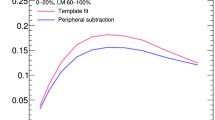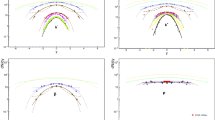Abstract.
Two-particle angular correlations have been widely used as a tool to explore particle production mechanisms in heavy-ion collisions. The mixed-event technique is generally used as a standard method to correct for finite-acceptance effects. We demonstrate that event mixing only provides an approximate acceptance correction, and propose new methods for finite-acceptance corrections. Starting from discussions about 2-dimensional correction procedures, new methods are derived for specific assumptions on the properties of the signal, such as uniform signal distribution or \( \delta\)-function-like trigger particle distribution, and suitable for two-particle correlation analyses from particles at mid-rapidity and jet-hadron or high p T -triggered hadron-hadron correlations. Per-trigger associated particle yields from the mixed-event method and the new methods are compared through Monte Carlo simulations containing well-defined correlation signals. Significant differences are observed at large pseudorapidity differences in general and especially for asymmetric particle distribution like that produced in proton-nucleus collisions. The applicability and validity of the new methods are discussed in detail.
Similar content being viewed by others
References
STAR Collaboration (C. Adler et al.), Phys. Rev. Lett. 90, 082302 (2003) arXiv:nucl-ex/0210033 [nucl-ex]
PHENIX Collaboration (K. Adcox et al.), Phys. Rev. Lett. 89, 212301 (2002) arXiv:nucl-ex/0204005 [nucl-ex]
CMS Collaboration (V. Khachatryan et al.), JHEP 09, 091 (2010) arXiv:1009.4122 [hep-ex]
ALICE Collaboration (B. Abelev et al.), Phys. Lett. B 719, 29 (2013) arXiv:1212.2001 [nucl-ex]
ATLAS Collaboration (G. Aad et al.), Phys. Rev. Lett. 110, 182302 (2013) arXiv:1212.5198 [hep-ex]
CMS Collaboration (S. Chatrchyan et al.), Phys. Lett. B 718, 795 (2013) arXiv:1210.5482 [nucl-ex]
L. Xu, C.H. Chen, F. Wang, Phys. Rev. C 88, 064907 (2013) Doi:10.1103/PhysRevC.88.064907
S. Ravan, P. Pujahari, S. Prasad, C.A. Pruneau, Phys. Rev. C 89, 024906 (2014) arXiv:1311.3915 [nucl-ex]
C.A. Pruneau, Phys. Rev. C 74, 064910 (2006) arXiv:nucl-ex/0608002 [nucl-ex]
V. Vechernin, On description of the correlation between multiplicities in windows separated in azimuth and rapidity, arXiv:1305.0857 [hep-ph] (2013)
PHOBOS Collaboration (B. Alver et al.), Phys. Rev. C 81, 034915 (2010) arXiv:1002.0534 [nucl-ex]
STAR Collaboration (J. Adams et al.), Phys. Rev. Lett. 95, 152301 (2005) arXiv:nucl-ex/0501016 [nucl-ex]
PHENIX Collaboration (S.S. Adler et al.), Phys. Rev. Lett. 97, 052301 (2006) arXiv:nucl-ex/0507004 [nucl-ex]
PHENIX Collaboration (A. Adare et al.), Phys. Rev. C 78, 014901 (2008) arXiv:0801.4545 [nucl-ex]
CMS Collaboration (S. Chatrchyan et al.), Phys. Lett. B 724, 213 (2013) arXiv:1305.0609 [nucl-ex]
L. Adamczyk, Long-range pseudorapidity dihadron correlations in $d + $ Au collisions at $\sqrt{s_{NN}} = 200$ GeV, arXiv:1502.07652 [nucl-ex] (2015)
PHENIX Collaboration (S. Adler et al.), Phys. Rev. Lett. 96, 222301 (2006) arXiv:nucl-ex/0603017 [nucl-ex]
STAR Collaboration (M. Aggarwal et al.), Phys. Rev. C 82, 024912 (2010) arXiv:1004.2377 [nucl-ex]
N. Ajitanand, J. Alexander, P. Chung, W. Holzmann, M. Issah et al., Phys. Rev. C 72, 011902 (2005) arXiv:nucl-ex/0501025 [nucl-ex]
T.A. Trainor, Phys. Rev. C 81, 014905 (2010) arXiv:0904.1733 [hep-ph]
T. Sjostrand, L. Lonnblad, S. Mrenna, PYTHIA 6.2: Physics and manual, arXiv:hep-ph/0108264 [hep-ph] (2001)
J.-Y. Ollitrault, Phys. Rev. D 46, 229 (1992)
A.M. Poskanzer, S.A. Voloshin, Phys. Rev. C 58, 1671 (1998) arXiv:nucl-ex/9805001 [nucl-ex]
Author information
Authors and Affiliations
Corresponding author
Rights and permissions
About this article
Cite this article
Oh, S., Morsch, A., Loizides, C. et al. Correction methods for finite-acceptance effects in two-particle correlation analyses. Eur. Phys. J. Plus 131, 278 (2016). https://doi.org/10.1140/epjp/i2016-16278-0
Received:
Accepted:
Published:
DOI: https://doi.org/10.1140/epjp/i2016-16278-0




